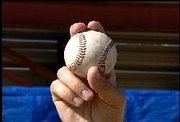So when you are watching this week, you may wonder whose curveball breaks harder, the Yankees' A.J. Burnett or the Phillies' Cole Hamels. The answer will be a disappointing neither. Some of it is a trick of the eye.
First, what is a curve ball? A fastball in baseball has back spin, which gives it pretty recognizable aerodynamics while coming at the batter, but a curveball, due to its grip, has a diagonal spin. You might think it's a great idea - and it is - but it has its dangers. A curveball in a bad location, with its greater topspin, can have terrific backspin if hit.

Let's revisit the Magnus effect and why it makes a curveball do cool things. The backspin of a fastball creates a high-pressure zone in the air ahead of and under the baseball due to the baseball's raised seams. The topspin of a curveball creates a high-pressure zone on top of the ball, which deflects the ball downward in flight, which combined with the awesome power of gravity, gives the ball more of a drop.
Magnus Force
Velocity
 Drag
Drag


Spinning ball
But how much is that break really?
It depends. Debate on the 'illusion' aspect of the curveball has been evident since science has been able to look at vision and thrown balls. In 1949, Sikorsky aero engineer Ralph B. Lightfoot used wind tunnel tests to show that a curve ball does actually curve but it is not as dramatic (up to 20 inches) as players actually think it is. That's because of the way our brain processes a spinning object.
When we view a spinning object directly its motion is interpreted correctly by our brains. But as the Magnus effect causes the trajectory of a baseball to move from the center of our vision to our peripheral vision, the effect is exaggerated.
Zhong-Lin Lu, professor of cognitive neuroscience at USC, along with Emily Knight and Robert Ennis and Arthur Shapiro, associate professor of psychology at American University, developed a simple visual demo that won the Best Visual Illusion of the Year prize at the 2009 Vision Sciences meeting and it demonstrates that a curveball's break is, at least in part, an effect is due to the batter being forced to switch between peripheral vision and central vision during a swing.
When you watch the ball directly it falls vertically but, as they write, if you focus on the blue dot and use your peripheral vision to detect the spinning object, it appears to fall at an angle. If you shift your gaze during its fall, it appears to 'break'.
Give it a try at http://illusioncontest.neuralcorrelate.com/2009/the-break-of-the-curveball/.NOTES:
(1) And Happy Haitians and why so many homeruns are being hit at the new Yankee Stadium and more.





Comments